Porcelain Insulator News
by Jack H. Tod, NIA #13
Reprinted from "INSULATORS - Crown Jewels of the Wire", August 1980, page 11
Dear Jack:
Enclosed is a drawing of an insulator [and
which is U-38] I recently purchased at a flea Market for $.25. I was attracted
to it by its very small size. It is really crude looking, has a grayish-white
glaze, and even has some factory defects occurring before it was glazed. It has
no markings, but there is a small spot in the center of the dome, as if turned
on a lathe, and there appears to be something like file marks on the-unglazed
bottom rim.

What is this thing, Jack, and did I get ripped off for my quarter or
what?? Any idea on how old it is or how much it might be worth?
Joe Kowulich
Elmira, N.Y.
- - - - - - - - - -
Dear Joe:
You got a nice old insulator for the two-bits. This is a
Fred Locke item, roughly 1899-1901. It's style U-38 in our style chart. Whereas
the slightly later U-39 version usually comes in brown, the U-38 is normally
white.
The brown U-39's with Fred Locke marking are roughly a $5 insulator,
maybe bit more at best. The white ones with Fred Locke marking are in the $10 to
$15 range, quite scarce really. But I can't recall having heard of one without
the marking. I'd hazard a guess it is still a $5 insulator.
The unglazed firing
rest on the bottom rim is typical of that era. As opposed to more modern methods
of coating the firing rest with paraffin to shed the unwanted glaze in that area
when dipped in the glaze, the early practice was to just dip the whole insulator
in the glaze vat and then later fettle off the unwanted glaze from the firing
rest with a piece of canvas or whatever. Before firing, the glaze is very
fragile, just about like chalk, and you can just rub it off with your finger
tip. In my event, this rubbed-off area gives the "filed" appearance
you mention. I think for the sake of speed, they just removed the unwanted
powdery glaze by hitting the insulators a quick lick on a belt sander.
Jack
Dear Jack:
The article in the April CJ issue about the U-418 Locke
insulator & copper shroud caught my attention right away. I went to visit
Robert Chiantelli, and both of us together went to different areas of Monterey
and Watsonville to look at some of these in service. Enclosed are some
telephotographs I took of some of them.
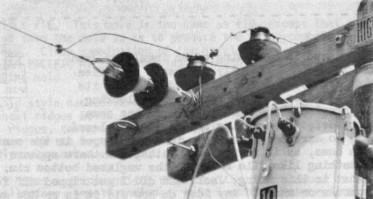
The above photo shows a pole with the
original U-418 type of Fog Bell used with the metal fog shrouds (pans). About
1970 I saw many U-418A and a few U-418, many with copper fog shrouds and a few
without shrouds, from Moss Landing to about 10 miles west of the Santa Cruz
area. But lately, very few of these remain in service. Since I've never found
these shrouds in use outside the Monterey Bay area, it led me to believe that
these were specially made for use in this area.
The fog is always a frequent
problem for many power companies along the coast. When the Monterey County Gas
& Electro Co. (1903-1912) or Coast Valleys Gas & Electric Co.
(1912-1927, hence merged with P.G.& E.) first put up the lines around
Monterey, the company used different insulators for the new lines. The early
company probably had problems with salt, dirt and moss contamination under the
insulator skirts, and the combination of the fog shrouds and the U-418 Fog Bell
insulators was their hope for a remedy. Later on the now-familiar U-855 Fogbowl
insulators were designed and made for replacing existing insulators in fog prone
areas and probably ended further installation of the fog shroud arrangement.
Many lines in the Los Angeles area, especially within about 10 miles of the
seacoast, have lots of these U-855's in use at the present time.
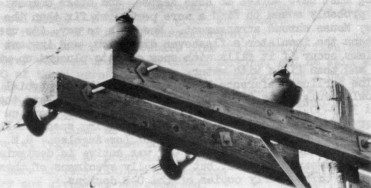
The
above photo surely must be a climax to this sequence of events. It shows a pair
of U-855 Fogbowls which were used to replace the obsoleted U-418 Fog Bells. Note
that the fog shrouds, which are held in place by the pin flange, were just left
in place instead of being discarded.
Any comments you may have regarding the
enclosed photos and information is always welcome.
Richard A. Peterson
Oakland,
Calif.
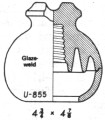
- - - - - - - - - - -
Comments? You better believe it! The above information has possibly
answered questions to several puzzles none of us have ever been able to solve. I
consider it the information find of the year -- if not the past several years. [I
have slightly edited Richard's letter to make the text fit the sequence of the
photos included above.]
The earliest known reference to the U-418 that I've
found is Locke's factory drawing of it, and the drawing is dated 11-12-22. (The
Thomas factory drawing for the same style is dated 6-10-27.)
It always puzzled
me why the factory termed this a "fog insulator" from the outset, even
though it basically is about the same shape as most cable insulators. Its sole
distinction is that unique concave skirt which makes it different from, all the
others. We may now have an answer, and I'm willing to bet on the following
theory.
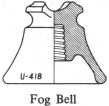
That is, the special U-418 and the copper fog shroud were
designed as one total device to be used together, and these were put into test
in a coastal area (Monterey Bay, if not also elsewhere). There most certainly is
a Locke patent on the scheme, but I never ran onto it in my searches. The
general idea of the upward protection from contaminants borne by fog must have
worked to some degree, and other companies were probably moved to find a more
permanent fix than the Mickey Mouse shroud arrangement. Needless to say, its use
shortens the insulator's flashover dimension, and instant problems occur if it
fills with snow or gets plugged up with dust and then fills with water.
The
earliest reference I could find to the proverbial Fogbowl insulator is O-B's
factory drawing of one, and that's dated 3-27-30. O-B's more streamlined version
appears on a factory drawing dated 2-28-31, and the drawing specifically states
these were made for the city of Los Angeles. G.E. has records showing Locke
Insulator Co. was active in designing Fogbowls as early as 1932, but generally
specimens of those show them to be nearly copies of the O-B designs.
It follows
then that the appearance of the all-porcelain Fogbowls was the ultimate cure,
and that ended the short life of the U-418/plus/shroud arrangement. Because of
the defects of that mentioned above, the shrouds were probably quickly removed
and discarded in the 1930's. By lucky chance several did survive in the Monterey
area so we could put in place the last several pieces of the Fogbowl history
puzzle.
The U-418 (and variants) still survived, since there are always a few
utilities who aren't fussy about using any old insulator styles as long as
they are serviceable. Besides Thomas making the U-418 from 1927 up into the
1930's, Westinghouse also made them. The Thomas 1930 catalog touts them as
"... especially designed for use in salt-fog belts, around cement works,
coke ovens, mill, railroads and dusty locations." The catalog never said
anything though about their use with a shroud underneath; maybe Locke did have a
patent on that part of it?
Well, if you collect the Fogbowl insulators and think
you have them all, I guess you really don't. You're missing the very first one
-- a U-418 with this special fog shroud. Put in that perspective, I think
collectors should treat it as an early classic for the set -- a real goody!
We are
indebted to Robert for bringing these to our attention last spring, and to
Richard for sending the info on their early use so we could complete the
picture.
Jack

Dear Jack:
I had the opportunity the other night to visit a
former salesman for the A. B. Chance Co. He had a small insulator collection
that he had accumulated over the years. His glass was all common, but his
porcelain insulators and go-withs were quite impressive, including several large
O-B cables in green and cobalt, and a number of old Lapp insulators, etc.
He
also had a dark cobalt blue distribution insulator (above) with an underglaze
CHANCE marking, and he said about 2000 of these were made as marker insulators
on a particular line. He also told me of 2000 other Chance insulators made in
canary yellow for the same type of development.

One of his most striking items
was an advertiser as I've sketched here (at right). These coffee cups were given
out as promotional items and were of very limited production. Every one given
out was recorded. It was in the shape of an inverted insulator, sky glaze with
black radio treated top. The company name and advertising lines were applied
underglaze.
At the end of a most enjoyable evening, I ended up with an armload
of goodies -- insulators, promotional items and other paraphernalia.
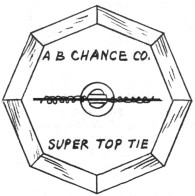
One
advertiser I got was a paper weight showing Chance's Super Top Tie insulator.
This is an octagonal clear resin embedment of a miniature insulator, line wire
and tie wire (sketch at left).
Another item was a bell-shaped fog suspension
(with three external "fins") which has markings A B C / 1000 M&E/
5000 TEST -- and also another one perfectly sectioned in half.
However, the one
that pleased me most was an early 10" Hewlett suspension disk (flat top)
with the G.E. and Thomas names and patent dates around the edge. And it was
complete with the specially-designed, copper, quick-detach mounting terminals
made by Thomas (with R. T. & S. marking plus "PAT'D / JAN. 9 /
1923"). It in a mottled gray-black. I find it a most interesting piece.
Robert Lloyd
Windsor, Ontario, Canada
- - - - - - - - - -
Dear Robert:
Really great, you
lucky devil. I'll let you have the nice Hewlett suspension, but I'd like to know
what my "CHANCE" is to get that insulator coffee cup. Ask him what his
blood type is and how many pints it would take.
Jack
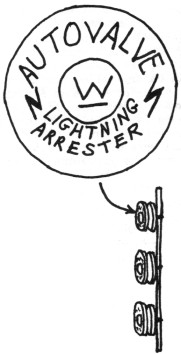
Dear Jack:
A friend of mine owns
an antique store here in Klamath Falls, and one of his customers brought in a
set of 3 lightning arresters where are attached to a bar-type bracket. I'm
enclosing a very crude sketch of it.
Each arrestor is about 6" diameter, a
brass base with a white porcelain cap as shown. There is a a bunch of small,
solid glass marbles inside each unit, about the size of a filbert nut, and these
are of different colored glass (including cobalt blue). As you can see, the
assembly was a Westinghouse product.
I haven't the slightest idea of the exact
use of this item, its age, or its approximate value to a collector of such
things. Any info you could give would be greatly appreciated.
Bill Hungate NIA
#565
Klamath Falls, Oregon
- - - - - - - - - -
Dear Bill:
I can't tell you anything about the
lightning arrestor you describe -- exact use, vintage etc. As you can imagine,
there have been literally millions of different gadgets in the past 90+ years of
power line construction and related equipment, so it's a very chancy thing that
we'd know details about any of the older things that were used in the past.
But,
as opposed to some gadgets we know to be electrical but can't identify, at least
we would know that this is indeed a lightning arrester and that it was made by
Whse.
Also can't help with regard to possible value to collectors. Any such
items are worth just what someone is willing to pay for it, and that's
presupposing that a person who would pay to obtain it crosses paths with someone
who has it and wants to sell it.
Jack

Dear Jack:
My brother-in-law (nice guy)
gave me a white porcelain distribution insulator (U- 297) last week, and it has
a Circle-ITE crown marking, He told me a lineman from the Reading Railroad gave
it to him.
Gerald Brown lists this in his book in blue, but not white. Is this
insulator unusual in white, and what kind of value would you put on it? Finally,
what does the ITE stand for?
Joe Pearson
Sellersville , PA
- - - - - - - - -
Dear Joe:
Gerald
listed in his books only specimens which he had in his collection or which were
definitely known to exist by virtue of reports from other collectors. As far as
various combinations of style, colors and markings go, all the porcelain pin
types in all the collections put together might represent only a fraction of
what has been made in the past 90 years by so many different companies.
The
I-T-E insulator you have is from ITE-Imperial Corp., Victor, N.Y. This company
bought out the prior company, Victor Insulators, Inc. (1935-1953) there in 1953.
Subsequently Gould, Inc. bought the plant from ITE-Imperial a couple of years
ago and is now using the Gould logo on the insulators. Thus, the I-T-E marking
is now defunct.
The insulator you have was a stock item of I-T-E up into at
least the early 1970's. I once had two cartons (100 pieces) of these in white
which I got from the factory in 1972, and I used to put them an my show table
with a $1.00 sticker as I recall. I now have none, since all the remaining ones
were in one lot of three 3/4-ton pickup loads (literally) I sold to a Calif.
party several years ago. He was not a collector but wanted all the common,
low-valued items for some venture in "novelties" he had going.
In any
event, discounting my adventures with it, I'd say trade value on these would be
$1 to $2 at best, since they are a modern item of a large manufacturer.
Jack
Dear Jack:
Thank you for offering the special price on your latest book,
Electrical Porcelain, and I've enclosed a check.
I have specialized in American
Telephone & Telegraph Co. insulators for the past six years and have in my
collection either specimen or pictures of the basic styles of glass insulators
used by A T & T. I also have a few different porcelain beehives that were
supposedly also used by them.
What I request from you is any information you
have concerning A T & T and porcelain. Did they order specialty porcelain
for their many early transcontinental open wire lines? These were after 1890, so
should be available in an up-to-date library like yours.
Steve Shearer, NIA
#1150
Franklin, Indiana
- - - - - - - - - -
Dear Steve:
Well, other than 180 pages of other
interesting material, you're off to a roaring start with the book on A.T.&
T., in that the book was used as a vehicle to publish essentially all of my
patent info, in brief form for all items not pertinent to book title. You'll
find quite a few AT&T patents in the listing, and it might be nice if you
could either look these up in the patent Gazettes if available at your library,
or otherwise order them at the cheap $.50 each from Washington. To order patent
copies, see info at top of page 124 in the book. I'll list a few AT&T for
you, so you won't miss them. Page numbers below are pages in the book.
#1,760,983 (page 158) specifically covers the CD-194/195 as made for A.T. &
T.
#2,734,098 (page 159) specifically covers the CD-203.2, and I've corresponded
considerably with Woody about this one. The reason for the side groove
arrangement was to hold an elastic (rubber) mid-skirt rain-shed. As I understand
it, this is a rare style in collections, and we've speculated that only a
limited number were made for test -- and possibly were never put into actual use
on any working line.
#1,708,038 (page 160) A.T.& T. Specifically the CD-176.
#1,700,166 (page 161) A.T.& T. An in-line dry-spot insulator. Would be fun
to search out one of these and add to your collection -- if indeed such items were
ever made.
#1,703,853 (page 161) Specifically the U-173 dry-spot insulator,
essentially identical with glass CD-182 idea. This is a Postal Tel Cable Co.
patent, but is of possible interest due to communications line usage.
#1,694,415 (page 161) Possibly never made, but it's an A.T.& T. patent.
A
number of the many other pin type patents listed in the book may have had some
A.T & T. origin, but I only referenced them A.T.& T. if the patent was
actually assigned to A.T.& T. Trust that at least the above will be helpful.
In answering your other questions, I just don't have any info on which porcelain
insulators are probably closely related to A.T.& T. as re origin or line usage. I'm sure they probably used a great deal of porcelain insulators, and
especially for specific conditions -- such as possibly in vandal-prone areas as
vs. use of glass insulators. They possibly used porcelains where their lines
were comingled with other lines (both power and communications lines) which did
use porcelain. I have considerable info an the manufacture and history of the
insulators themselves but essentially very little as to who used what, and
especially on communications-type lines. Similarly, you could best find info on
possible use on early transcon lines from people who've spent time chasing down
lines afield or who have researched construction and usage of these old lines.
I'm a pretty dry source for that type of info.
Jack

Dear Jack:
I was looking at the #3 recess-embossed marking (above) of the Ohio Brass Co.
in your book, and I have found one which is somewhat different.

This one, as shown by the foil impression I've enclosed, has two
radial bars which extend down at an angle from the O-B monogram instead of
horizontally. It's probably no big deal, but I am curious. Is it just one of
many variations, or is it unusual?
Tim Wood, NIA #1099
Scio, Oregon
- - - - - - - - -
Dear Tim:
I don't have any
info on the reasons for the radial bars on the Ohio Brass recess-embossed
marking device. It could have been used for dating or special identification at
one time, but anything we might dream up for it would be a useless guess. I
never inquired about it on my visits to the O-B factory in past years.
Years ago
I saw this type of marking device in use at the insulator trimming stations in
the O-B factory at Barberton, Ohio. It is mounted on the end of an angle iron
which is held back from the insulator with a door spring. After quickly spinning
the insulator to trim it, the spindle is stopped, and the worker just swats the
hinged marking device against the side of the insulator.
Those radial bars just
have to come about from an intentional filing of notches in the marking device,
so they definitely mean something. I put the marking in the book listings even
though I didn't know the meaning of the radial bars at the time -- and still
don't.
Jack
| 